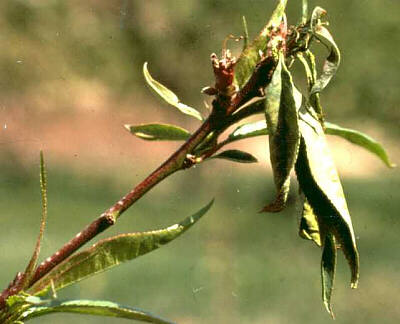|
|
||||||
 |
||||||
|
|
|
|
|
|
||
Peach Twig Borer (Anarsia lineatella)HostsPeach, apricot, nectarine, plum, pruneDamageIn the spring, larvae bore into buds and developing shoots causing them to wilt and die. Larvae of the summer generations attack the fruit, usually making several entry holes near the stem end. Damaged fruit and twigs exude gum.
IdentificationLarva - Reddish-brown with pale to white segments giving a ringed appearance; head and thorax dark brown to gray. Mature larvae up to 12 mm long.Adults - Grayish moths, 11 mm long.
Life HistoryOverwinter as larvae on host trees and are active March to early May. First brood adults are present in May and June during which time they lay eggs on leaves, fruit or twigs. First generation larvae are present June through early August. Second brood adults appear in late July and lay eggs for the second generation of larvae, which appear in late September to feed for a short time before seeking overwintering sites. There are two generations each year with a partial third in some years.MonitoringPheromone-baited traps are useful in monitoring male moths in order to properly time spray applications against spring and summer broods of larvae. Careful examination of developing shoots and buds (spring) and fruit (summer) for presence of larvae will also aid in proper timing of sprays.ControlBiological - Bacillus thuringiensis (Bt) products have been effective if applied when larvae are first noticed and before they tunnel into twigs, buds or fruit.Chemical - If an average of two or more first brood moths are caught per trap per week, apply treatments 10-14 days later to control adults and emerged larvae. To ensure good crop protection, continue monitoring for second brood moths until at least mid-August. If required, apply a second spray 10-14 days after the average catch of five moths per trap is exceeded. Endosulfan provides 2 weeks protection, azinphos-methyl 3 weeks, and phosmet 2 weeks. Recommended treatments and timing are:
February 2004
Return to Tree Fruit Pests and Diseases
|
|||||||||||||||||||||
|
|
|||||||||||||||||||||


